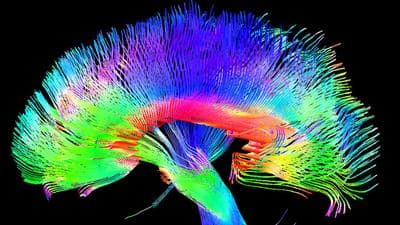Advertisement
Psychiatrist: Why I'm Cheering For The Obama Brain Project

I recently moderated a panel featuring three top figures in psychiatry and neuroscience, and when an audience member brought up the Obama plan for a brain activity mapping project, all three responded identically: "I'm skeptical."
I asked Dr. Steven Schlozman — assistant professor of psychiatry at Harvard Medical School, staff child psychiatrist at Massachusetts General Hospital, and author of “The Zombie Autopsies” — to explain such skepticism and describe how he'd propose spending $100 million on the brain.
By Dr. Steven Schlozman
Guest contributor

I’m actually giddy about the President’s proposal. Remember, I’m writing here as a clinician and an educator. I have not been battered by the false promises of the past in this particular arena. To fully appreciate my optimism, do this:
Imagine that you are an anatomy student in the dark days of the 12th century. You look out your window at the primitive road that passes your quarters. The plowed fields in the distance help to distract you from the vexing mystery that sits now on your desk.
There, on your wooden dissecting table, sits a recently removed human brain.
What a mess.
You see, you’ve figured out the heart. You’ve held it and squeezed it and using nothing but observational perseverance, you’ve gleaned that it is intended to pump blood, and that the blood only goes in one direction. You know an awful lot about this organ.
We physicians really don’t truly understand brain circuitry and yet we alter it in our patients every day.
You’ve done okay with other organs as well. You’ve blown air into cadaverous lungs and you’ve measured the extent to which human bladders are wonderfully impermeable. You are, in fact, pretty comfortable that our lungs move air and that our bladders hold liquid.
But what about that brain? You’ve picked it up, squeezed it, turned it over and over in your hands and you’ve tried to understand just what in God’s name this organ could possibly do. There are great big blood-carrying arteries that feed the brain, as well as great big blood-carrying veins that empty it. Perhaps the brain is for cooling the blood?
That’s the best you can do with the tools you have, so you reluctantly write it all down in your journal. (That’s what folks thought for a long time about the brain.) Still, you think, whenever a man is struck in the head, he behaves differently; he seems possessed, alienated from his true self. You just can’t figure out how that mass of gray goo sitting on your dissecting table can account for something as profound as the changing self.
And this is where neuroscience sat for hundreds of years.
Think about this: We physicians really don’t truly understand brain circuitry and yet we alter it in our patients every day. We doctors can't even begin in any meaningful or understandable way to explain the synergistic, iterative and downright miraculous way that our brains use all of that mysterious circuitry to draw complex conclusions or to make kick-ass music or to write a half-decent sonnet. We don't, in other words, have an acceptable grasp of the science that goes into being human.
This isn’t our fault; some of these mysteries just couldn’t be solved until very recently.
It seems to me immensely important that if we want to make reasonable sense of ourselves, we must in turn excite our very culture about how best to understand this story. And this story is in the brain. It is particularly ironic that we fail to understand how little we know about the very organ that helps us to know anything in the first place.
Just as the nascent years of NASA were intended to tap the inherent optimism of public interest in the mysterious, the recent announcement of a newly invigorated effort to make sense of the brain has itself served to ignite a real-time discourse that will without question yield downstream projects.
As a clinician, I’d want this project to consider the enormous burden of psychiatric illness. As a child psychiatrist, I am especially interested in converting whatever is gleaned from these new endeavors into a more proactive stance towards the neuropsychiatric suffering of children and adolescents.
Wouldn’t it be marvelous, for example, if we could develop a truly neurobiological assessment of the possibility for the development of psychiatric disease? We could change the environment for the child at risk and create instead a world that would confer resilience. We could use the very brain plasticity that we’ve only just learned about to set a child’s neural pathways towards a healthier course. The future of health care has got to be at least as proactive as reactive. As of now, we lack the tools to make these predictions with the degree of accuracy that I’d hope more attention to brain science will afford.
While we’re at it, wouldn’t it be great to know more about the exquisite balance between emotion and cognition? How do we make decisions? Clearly, both thoughts and feelings matter. “Only connect the prose and the passion,” wrote Forster, “and both will be exalted.” Would it be possible for us to quantifiably understand how much emotion makes for careful thought? Could that help us to understand not only our interpersonal conflicts but also our international battles? Political scientists have taught us about the dangers of “hot cognitions” for years, but do we really know how hot is too hot?
And finally, what are we doing to our brains as we indulge in ever-expanding technological interaction? Do the neural pathways of our children look different? Is this a good thing, a bad thing, or just a new thing? We don’t know the answers to these very important enquiries, and yet we are raising our children in the most profoundly changed technological world since the advent of the automobile. We had better get a molecular grasp of how the grown-up mind of a digital native will function.
At the end of the day, these goals, and many more, will require a cooperative effort among folks who have until recently kept separate journals and separate lives. Neuroscientists, geneticists, engineers, primary care physicians, cell biologists, pathologists, biochemists, neurologists, neurosurgeons, psychiatrists, teachers, artists, computer scientists, policemen, politicians – and you and me. We all gotta start talking. This dialogue itself is well worth the endeavor.
This program aired on April 5, 2013. The audio for this program is not available.
